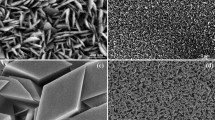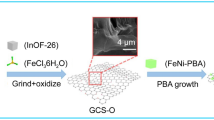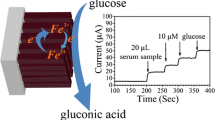Abstract
Improving the electron–hole separation efficiency and accelerating the reaction kinetics of semiconductors are effective methods for improving the photoelectric catalytic activity of TiO2. In this study, sulfur-doped TiO2 (S–TiO2) nanorod arrays grown on a fluorine-doped SnO2 transparent conductive glass were successfully prepared using a microwave-assisted method for the photoelectrochemical (PEC) biosensing of glucose. The charge separation efficiency on S–TiO2 was evaluated by subjecting the prepared material to X-ray photoelectron spectroscopy, PEC measurements, and theoretical calculations based on density functional theory. The results clearly showed that the sulfur impurity state could not only reduce the bandgap but also serve as “stairs” to facilitate the electron transfer. Sulfur atoms that were successfully doped into TiO2 significantly promote the separation of the photogenerated carriers and improve the photocatalytic activity of the photoelectrode. Consequently, excellent glucose-detection sensitivities of 54 and 19 μA mM−1 cm−2 were achieved for fragments with sizes of 0.1–1.5 and 2–12 mM, respectively.





Similar content being viewed by others
References
Barham JP, Konig B (2020) Synthetic photoelectrochemistry. Angew Chem Int Ed Engl 59:11732–11747
Zhao WW, Xu JJ, Chen HY (2017) Photoelectrochemical enzymatic biosensors. Biosens Bioelectron 92:294–304
Dey S, Roy SC (2021) Hydrothermal temperature-controlled size and distribution of CeO2 nanoparticles over TiO2 nanorods: heterojunction characteristics and photoelectrochemical performance. Ceram Int 47:14603–14611
Saha S, Chan Y, Soleymani L (2018) Enhancing the photoelectrochemical response of DNA biosensors using wrinkled interfaces. ACS Appl Mater Interfaces 10:31178–31185
Fan B, Fan Q, Hu L, Cui M, Wang X, Ma H, Wei Q (2020) Polydopamine-PEG-folic acid conjugate film engineered TiO2 nanotube arrays for photoelectrochemical sensing of folate binding protein. ACS Appl Mater Interfaces 12:1877–1884
Kang Q, Zhang Q, Zang L, Zhao M, Chen X, Shen D (2020) Enhancement anti-interference ability of photoelectrochemical sensor via differential molecularly imprinting technique demonstrated by dopamine determination. Anal Chim Acta 1125:201–209
Kang Z, Li Y, Cao S, Zhang Z, Guo H, Wu P, Zhou L, Zhang S, Zhang X, Zhang Y (2018) 3D graphene foam/ZnO nanorods array mixed-dimensional heterostructure for photoelectrochemical biosensing, inorganic chemistry. Frontiers 5:364–369
Çakıroğlu B, Özacar M (2018) A self-powered photoelectrochemical glucose biosensor based on supercapacitor Co3O4-CNT hybrid on TiO2. Biosens Bioelectron 119:34–41
Sui C, Zhou Y, Wang M, Yin H, Wang P, Ai S (2018) Aptamer-based photoelectrochemical biosensor for antibiotic detection using ferrocene modified DNA as both aptamer and electron donor. Sens Actuators B Chem 266:514–521
Chen D, Zou X, Dong F, Zhen C, **ao D, Wang X, Wu Q, Cao Y, Tu J (2021) Donor-acceptor compensated ZnO semiconductor for photoelectrochemical biosensors. ACS Appl Mater Interfaces 13:33006–33014
Kang Z, Gu Y, Yan X, Bai Z, Liu Y, Liu S, Zhang X, Zhang Z, Zhang X, Zhang Y (2015) Enhanced photoelectrochemical property of ZnO nanorods array synthesized on reduced graphene oxide for self-powered biosensing application. Biosens Bioelectron 64:499–504
Wang L, Gu W, Sheng P, Zhang Z, Zhang B, Cai Q (2019) A label-free cytochrome c photoelectrochemical aptasensor based on CdS/CuInS2/Au/TiO2 nanotubes. Sens Actuators, B Chem 281:1088–1096
Qin Y, Wen J, Zheng L, Yan H, Jiao L, Wang X, Cai X, Wu Y, Chen G, Chen L, Hu L, Gu W, Zhu C (2021) Single-atom-based heterojunction coupling with ion-exchange reaction for sensitive photoelectrochemical immunoassay. Nano Lett 21:1879–1887
Vinoth S, Shalini Devi KS, Pandikumar A (2021) A comprehensive review on graphitic carbon nitride based electrochemical and biosensors for environmental and healthcare applications. TrAC Trends Anal Chem 140:116274
Zhang J, Zhang X, Gao Y, Yan J, Song W (2021) Integrating CuO/g-C3N4 p-n heterojunctioned photocathode with MoS2 QDs@Cu NWs multifunctional signal amplifier for ultrasensitive detection of AβO. Biosens Bioelectr 176:112945
Puga ML, Venturini J, Guaglianoni WC, Ruwer TL, Wermuth TB, Bergmann CP (2021) Aluminium-doped TiO2 nanotubes with enhanced light-harvesting properties. Ceram Int 47:18358–18366
Miao Z, Wang G, Li L, Wang C, Zhang X (2019) Fabrication of black TiO2/TiO2 homojunction for enhanced photocatalytic degradation. J Mater Sci 54:14320–14329. https://doi.org/10.1007/s10853-019-03900-2
Gao J, Yang W, Fang C, Liang J, Cheng T, Li P, Guo X, Jung Y, Wang Y, Dong X (2021) Facile synthesis of TiO2/WO3 nanocomposites and the electrochemical lithiation/delithiation activity. J Mater Sci 56:14505–14517. https://doi.org/10.1007/s10853-021-06219-z
Jiang Z-Y, Zhao Z-Y (2018) Comparison studies of interfacial energetic and electronic properties of bimetallic AuCu/TiO2 hetero-structures from DFT calculations, Inorganic Chemistry. Frontiers 5:1062–1075
Yang W, Shen H, Min H, Ge J (2020) Enhanced acetone sensing performance in black TiO2 by Ag modification. J Mater Sci 55:10399–10411. https://doi.org/10.1007/s10853-020-04703-6
Zhang X, Yue D, Zhang L, Lin S (2020) Three-dimensional flexible Au nanoparticles-decorated TiO2 nanotube arrays for photoelectrochemical biosensing. J Mater Sci Technol 56:162–169
Yang W, Xu W, Wang Y, Chen D, Wang X, Cao Y, Wu Q, Tu J, Zhen C (2020) Photoelectrochemical glucose biosensor based on the heterogeneous facets of nanocrystalline TiO2/Au/glucose oxidase films. Acs Applied Nano Materials 3:2723–2732
Wang Q, Yu P, Bai L, Bao R, Wang N, Cheng C, Liu Z, Yang M, Yang W, Guo Z (2017) Self-assembled nano-leaf/vein bionic structure of TiO2/MoS2 composites for photoelectric sensors. Nanoscale 9:18194–18201
Yao X, Hu X, Zhang W, Gong X, Wang X, Pillai SC, Dionysiou DD, Wang D (2020) Mie resonance in hollow nanoshells of ternary TiO2-Au-CdS and enhanced photocatalytic hydrogen evolution. Appl Catal B: Environ 276:119153
Lü X, Mou X, Wu J, Zhang D, Zhang L, Huang F, Xu F, Huang S (2010) Improved-performance dye-sensitized solar cells using Nb-doped TiO2 electrodes: efficient electron injection and transfer. Adv Func Mater 20:509–515
Chen X, Burda C (2008) The electronic origin of the visible-light absorption properties of C-, N- and S-doped TiO2 nanomaterials. J Am Chem Soc 130:5018–5019
Deng X, Wang Y, Cui Z, Li L, Shi C (2018) Y-do** TiO2 nanorod arrays for efficient perovskite solar cells. Superlattices Microstruct 117:283–287
Tang R, Yin L (2015) Enhanced photovoltaic performance of dye-sensitized solar cells based on Sr-doped TiO2/SrTiO3 nanorod array heterostructures. J Mater Chem A 3:17417–17425
Li M, **ng Z, Jiang J, Li Z, Kuang J, Yin J, Wan N, Zhu Q, Zhou W (2018) In-situ Ti3+/S doped high thermostable anatase TiO2 nanorods as efficient visible-light-driven photocatalysts. Mater Chem Phys 219:303–310
Bakar SA, Ribeiro C (2016) A comparative run for visible-light-driven photocatalytic activity of anionic and cationic S-doped TiO2 photocatalysts: a case study of possible sulfur do** through chemical protocol. J Mol Catal A: Chem 421:1–15
Gao C, Wei T, Zhang Y, Song X, Huan Y, Liu H, Zhao M, Yu J, Chen X (2019) A photoresponsive rutile TiO2 heterojunction with enhanced electron-hole separation for high-performance hydrogen evolution. Adv Mater 31:1806596
Hsieh P-Y, Chiu Y-H, Lai T-H, Fang M-J, Wang Y-T, Hsu Y-J (2019) TiO2 nanowire-supported sulfide hybrid photocatalysts for durable solar hydrogen production. ACS Appl Mater Interfaces 11:3006–3015
Wang J (2008) Electrochemical glucose biosensors. Chem Rev 108:814–825
Shao Y, Wang J, Wu H, Liu J, Aksay IA, Lin Y (2010) Graphene based electrochemical sensors and biosensors: a review. Electroanalysis 22:1027–1036
Dong X-C, Xu H, Wang X-W, Huang Y-X, Chan-Park MB, Zhang H, Wang L-H, Huang W, Chen P (2012) 3D graphene-cobalt oxide electrode for high-performance supercapacitor and enzymeless glucose detection. ACS Nano 6:3206–3213
Liu B, Aydil ES (2009) Growth of oriented single-crystalline rutile TiO2 nanorods on transparent conducting substrates for dye-sensitized solar cells. J Am Chem Soc 131:3985–3990
Khan SUM, Al-Shahry M, Ingler WB (2002) Efficient photochemical water splitting by a chemically modified n-TiO2. Science 297:2243–2245
Klinowski J, Almeida Paz FA, Silva P, Rocha J (2011) Microwave-assisted synthesis of metal-organic frameworks. Dalton Trans 40:321–330
Gawande MB, Shelke SN, Zboril R, Varma RS (2014) Microwave-assisted chemistry: synthetic applications for rapid assembly of nanomaterials and organics. Acc Chem Res 47:1338–1348
Zhu Y-J, Chen F (2014) Microwave-assisted preparation of inorganic nanostructures in liquid phase. Chem Rev 114:6462–6555
Qi B, Wu L, Zhang Y, Zeng Q, Zhi J (2010) Low-temperature and one-step synthesis of rutile TiO2 aqueous sol by heterogeneous nucleation method. J Colloid Interface Sci 345:181–186
Balachandran U, Eror NG (1982) Laser-induced Raman scattering in calcium titanate. Solid State Commun 44:815–818
Bacsa R, Kiwi J, Ohno T, Albers P, Nadtochenko V (2005) Preparation, testing and characterization of doped TiO2 active in the peroxidation of biomolecules under visible light. J Phys Chem B 109:5994–6003
Jiang L, Luo Z, Li Y, Wang W, Li J, Li J, Ao Y, He J, Sharma VK, Wang J (2020) Morphology- and phase-controlled synthesis of visible-light-activated S-doped TiO2 with tunable S4+/S6+ ratio. Chem Eng J 402:125549
Ni J, Fu S, Wu C, Maier J, Yu Y, Li L (2016) Self-supported nanotube arrays of sulfur-doped TiO2 enabling ultrastable and robust sodium storage. Adv Mater 28:2259–2265
Yang C, Wang Z, Lin T, Yin H, Lü X, Wan D, Xu T, Zheng C, Lin J, Huang F, **. J Am Chem Soc 135:17831–17838
Umebayashi T, Yamaki T, Itoh H, Asai K (2002) Band gap narrowing of titanium dioxide by sulfur do**. Appl Phys Lett 81:454–456
Tang X, Li D (2008) Sulfur-doped highly ordered TiO2 nanotubular arrays with visible light response. J Phys Chem C 112:5405–5409
Su F, Wang T, Lv R, Zhang J, Zhang P, Lu J, Gong J (2013) Dendritic Au/TiO2 nanorod arrays for visible-light driven photoelectrochemical water splitting. Nanoscale 5:9001–9009
Wang G, Wang H, Ling Y, Tang Y, Yang X, Fitzmorris RC, Wang C, Zhang JZ, Li Y (2011) Hydrogen-Treated TiO2 Nanowire Arrays for Photoelectrochemical Water Splitting. Nano Lett 11:3026–3033
Parker RA (1961) Static dielectric constant of rutile (TiO2), 1.6–1060°K. Phys Rev 124:1719–1722
Li N, Zhang X, Zhou W, Liu Z, **e G, Wang Y, Du Y (2014) High quality sulfur-doped titanium dioxide nanocatalysts with visible light photocatalytic activity from non-hydrolytic thermolysis synthesis. Inorg Chem Front 1:521–525
Klahr B, Gimenez S, Fabregat-Santiago F, Bisquert J, Hamann TW (2012) Photoelectrochemical and impedance spectroscopic investigation of water oxidation with “Co–Pi”-coated hematite electrodes. J Am Chem Soc 134:16693–16700
Meng Y, Song W, Huang H, Ren Z, Chen SY, Suib SL (2014) Structure-property relationship of bifunctional MnO2 nanostructures: highly efficient, ultra-stable electrochemical water oxidation and oxygen reduction reaction catalysts identified in alkaline media. J Am Chem Soc 136:11452–11464
He Z, Mansfeld F (2009) Exploring the use of electrochemical impedance spectroscopy (EIS) in microbial fuel cell studies. Energy Environ Sci 2:215–219
Tee SY, Win KY, Teo WS, Koh L-D, Liu S, Teng CP, Han M-Y (2017) Recent progress in energy-driven water splitting. Adv Sci 4:1600337
Liu P, Huo X, Tang Y, Xu J, Liu X, Wong DKY (2017) A TiO2 nanosheet-g-C3N4 composite photoelectrochemical enzyme biosensor excitable by visible irradiation. Anal Chim Acta 984:86–95
Xu L, Tang C-Q, Qian J (2010) The first-principles study of absorption spectrum of C-doped anatase TiO2. Acta Phys Sin 59:2721–2727
Acknowledgements
This research was financially supported by the National Natural Science Foundation of China (No. 81860373, 21673097, 82060386), the Finance Science and Technology Project of Hainan Province (No. 2019RC221), the Ningxia Fostering Program for Innovative Leading Talents in Science and Technology (KJT2017003), CAMS Innovation Fund for Medical Sciences (No. 2019-I2M-5-023), Research and Cultivation Fund of Hainan Medical University (No. 19).
Author information
Authors and Affiliations
Corresponding authors
Ethics declarations
Conflicts of interest
The authors declare no conflict of interest.
Additional information
Handling Editor: Christopher Blanford.
Publisher's Note
Springer Nature remains neutral with regard to jurisdictional claims in published maps and institutional affiliations.
Supplementary Information
Below is the link to the electronic supplementary material.
Rights and permissions
About this article
Cite this article
Wang, Y., Yin, L., Wu, J. et al. Enhanced charge separation efficiency of sulfur-doped TiO2 nanorod arrays for an improved photoelectrochemical glucose sensing performance. J Mater Sci 57, 1362–1372 (2022). https://doi.org/10.1007/s10853-021-06617-3
Received:
Accepted:
Published:
Issue Date:
DOI: https://doi.org/10.1007/s10853-021-06617-3




